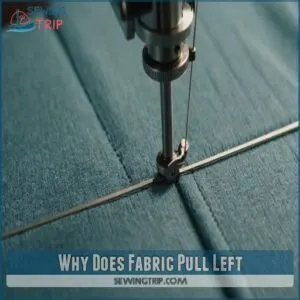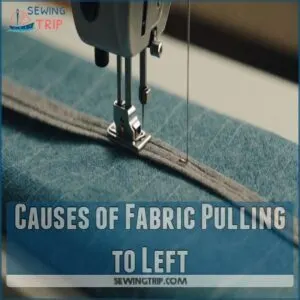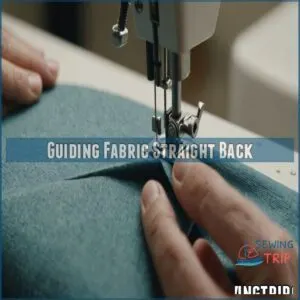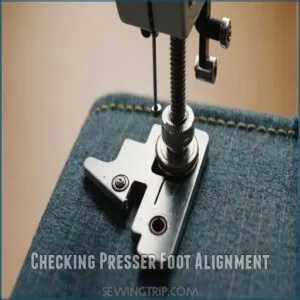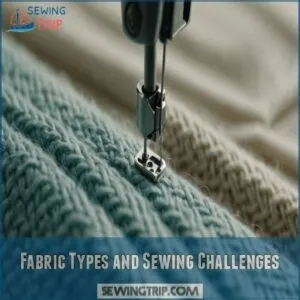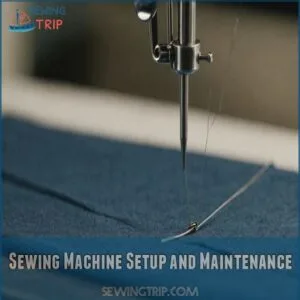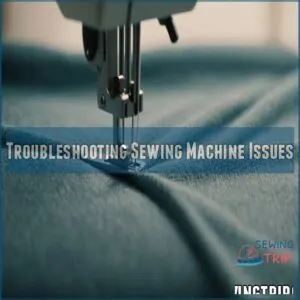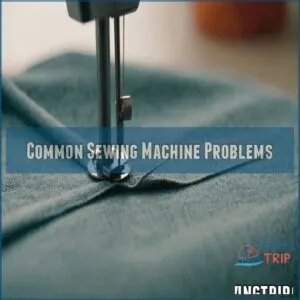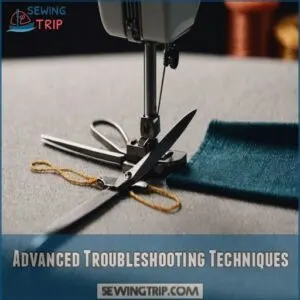This site is supported by our readers. We may earn a commission, at no cost to you, if you purchase through links.
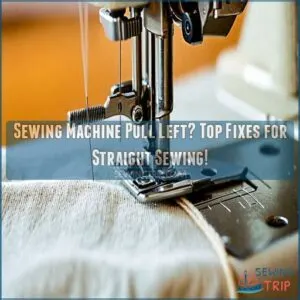
First, check the presser foot.
If it’s misaligned, a little adjustment can work wonders.
Next, make sure the fabric feeds evenly by inspecting the feed dogs for dirt or wear.
Using the wrong needle size can also cause mischief, so double-check that, too.
Heavy fabrics might sneakily slide; an extension table can give your project the support it craves.
Feeling like a sewing machine detective yet?
Stick around and become the master of your machine with more handy tips ahead!
Table Of Contents
- Key Takeaways
- Why Does Fabric Pull Left
- Causes of Fabric Pulling to Left
- Preventing Fabric Pull to Left
- Fabric Types and Sewing Challenges
- Solutions for Thin and Slippery Fabrics
- Sewing Machine Setup and Maintenance
- Troubleshooting Sewing Machine Issues
- Common Sewing Machine Problems
- Advanced Troubleshooting Techniques
- Repairing and Maintaining Sewing Machine
- Frequently Asked Questions (FAQs)
- Conclusion
Key Takeaways
- Check your presser foot alignment and tighten screws to prevent fabric from pulling left.
- Ensure feed dogs are clear of debris and properly aligned for even fabric feeding.
- Match your needle size with the fabric thickness to avoid stitch issues and fabric drift.
- Use an extension table for large or heavy fabrics to maintain balance and prevent gravity from pulling the fabric left.
Why Does Fabric Pull Left
Have you ever wondered why your sewing fabric keeps pulling to the left, as if it has its own plans?
It could be those heavier fabrics giving in to gravity or even those pesky lightweight materials going astray, but a little guidance and support can work wonders!
Heavy Fabric and Gravity
Ever wonder why heavy fabric‘s like a runaway train?
Gravity’s the sneaky culprit.
Understanding how to keep fabric from shifting while sewing is key, especially with adjusting sewing machine settings to match fabric type.
It pulls fabric left, making sewing feel like a wrestling match.
Lighten the load with a sewing table or walking foot attachment for balanced weight distribution.
Keep hands ready to guide the
Large Lightweight Fabrics
Struggling with large lightweight fabrics pulling to the left? You’re not alone! Here’s how to tackle it:
- Fabric Weight: Opt for heavier weights when you can to minimize shifting.
- Wind Resistance: A breezy environment can mess up your flow.
- Fabric Control: Use clips or pins to hold it steady.
- Sewing Techniques: Slow down your stitching—or else!
Fabric Drape and Support
Large lightweight fabrics draping awkwardly? That’s because they can pull left unexpectedly.
Make sure your fabric weight is well balanced on a roomy sewing table.
Ironing the fabric to remove wrinkles helps, and for more information on preparing your sewing machine, see sewing machine basics. A smooth fabric drape prevents unwanted movement, allowing you to master sewing machine stability.
Tweak fabric tension and consider a walking foot attachment for even feed.
Don’t let your fabric manipulate you; guide it confidently!
Causes of Fabric Pulling to Left
So, your fabric’s pulling left?
That’s a common sewing machine problem often caused by issues like thread bunching up under fabric, often caused by a misaligned presser foot, uneven feed dog contact, or using the wrong needle size.
Let’s troubleshoot these issues and get you sewing straight in no time!
Misaligned Presser Foot
Aligning that slippery fabric starts with your presser foot.
If it’s misaligned, your project won’t stay straight.
Here’s your toolkit:
- Screw tightening: Keeps the foot stable and centered.
- Leveling foot: Makes sure even pressure on the fabric.
- Foot adjustment: Corrects any sideways drift.
Small tweaks here bring big wins, keeping your sewing smooth.
Uneven Feed Dog Contact
After sorting out presser foot woes, let’s chat about uneven feed dog contact.
When fabric only touches the leftmost feed dog, especially with small seam allowances, it goes on a joyride left.
To avoid this, make sure to adjust your machine’s feed dog alignment properly – you can find products to help with this on websites that focus on feed dog alignment tools.
Incorrect Needle Size
You’ve checked the feed dogs, but the issue might lie with the needle size.
Using the wrong needle impacts stitch quality and thread compatibility, making fabric pull left.
Consider these tweaks:
- Match needle size to fabric thickness.
- Change needles regularly to prevent damage.
- Use the right needle for your thread.
- Check your sewing machine parts and sizes.
Preventing Fabric Pull to Left
If your sewing machine’s making a beeline to the left, don’t panic—it’s a common quirk!
Ensuring you’ve got an extension table can help keep your fabric from shifting as you sew.
Guiding fabric with your left hand helps control the fabric and prevents it from pulling to the side.
Checking presser foot alignment can help ensure that the needle is properly positioned over the fabric.
All of these tips can turn your sewing sessions from chaotic to smooth.
Using Sewing Machine Extension Tables
Does your fabric seem to wander left despite your best efforts?
Consider using a sewing machine extension table.
It’s like giving your fabric a helping hand!
These tables support the fabric’s weight and offer ample space for fabric drape, reducing uneven feed and fabric pulling.
Think of it as your secret weapon for straighter seams and stress-free sewing!
Guiding Fabric Straight Back
Isn’t it frustrating when your fabric keeps pulling to the left?
To tackle this, use your left hand to guide the fabric straight back.
It’s like keeping a toddler in line–steady, but gentle.
Make sure the fabric’s flat and work on steady hand movement, balancing fabric tension.
This technique helps avoid uneven fabric feed and creates smoother sewing.
Checking Presser Foot Alignment
Okay, so you’ve got your fabric feeding straight, right?
Now, let’s check that presser foot.
A wonky presser foot is a common culprit for sewing machine problems, especially when using the wrong type of foot for the job, such as a straight stitch foot that excels in precision sewing learn about sewing machine foot types explained. A wonky presser foot is a common culprit for sewing machine problems, especially that pesky leftward pull.
Here’s what to look for:
- Is it level?
- Are the screws tight?
- Does it sit evenly on the fabric?
Maintaining alignment is key for smooth sewing.
A little presser foot adjustment can make a world of difference!
Fabric Types and Sewing Challenges
When you’re working with fabrics like lightweight knits or slippery silks, it can feel like you’ve got a rebellious toddler under your presser foot.
These materials love to slip, stretch, and generally misbehave, making straight sewing a bit of a challenge.
Lightweight Knits and Silks
Taming lightweight knits and silks can feel like herding cats—they slip, slide, and sometimes pull to the left.
To tackle this, adjust your tension carefully.
Try a fine needle for precision.
Stabilizers like spray starch or a lightweight interfacing can be your secret weapon, keeping things steady and ensuring even feed.
This keeps your fabric from wandering off course.
Stretchy Fabrics and Traction Issues
When sewing stretchy fabrics, traction issues can make them pull left faster than a cat with a laser pointer.
Using the right needle type, such as a zigzag sewing needle, can really help.
Here’s how to tackle it:
- Stitch choice: Opt for a zigzag or stretch stitch.
- Thread tension: Adjust
Slippery Fabrics and Feed Dog Management
So, you’ve got that slippery fabric causing chaos with your feed dogs, right?
Fear not! Start by using stabilizers like tissue paper to help grip your fabric.
Adjust your stitch length and needle selection to suit the delicate fabric drape.
Remember, fabric tension matters!
With the right tweaks, you’ll conquer those sneaky, uneven fabric feeds in no time.
Solutions for Thin and Slippery Fabrics
If your lightweight fabric is slipping around like a newborn calf on ice, you’re not alone.
To keep things steady, try a stabilizer or sewing on a scrap piece of paper.
And avoid placing stitches right on the edge.
Using Stabilizers and Interfacing
Imagine sewing with silk—it’s like trying to hold a slippery fish!
For thin, wiggly fabrics, using fabric stabilizers is your secret weapon.
They help you keep control and maintain your fabric’s position.
Opt for different stabilizer types or interfacing uses to enhance fabric support.
Adjust your sewing machine tension settings by recognizing common signs of tension issues, such as uneven stitches and puckered fabric, which can often be resolved by fine-tuning the top thread tension and bobbin tension for a balanced stitch, as discussed in sewing machine tension adjustment tips. Adjust your sewing machine tension settings to minimize sewing machine problems, and voilà, sewing solutions achieved!
Sewing on Paper or Folded Fabric
For those slippery silks or flimsy chiffons, a clever trick is sewing a few initial stitches onto a piece of paper or folded fabric.
This gives your feed dogs something to grip, preventing that frustrating leftward pull.
Use a lightweight paper type, like tissue paper, and adjust your stitch length and fabric tension accordingly.
It’s a simple fix for a common sewing machine problem!
You’ll gain control and master those tricky fabrics in no time.
Avoiding Stitches Near Fabric Edge
After trying sewing on paper to steady things, watch out for stitches close to the fabric edge.
These can cause trouble, especially with thin or slippery fabrics like silk.
Keep a careful seam allowance and consider using the right needle size to avoid fabric pulling to the left.
Your feed dogs and presser feet will thank you!
Sewing Machine Setup and Maintenance
Keeping your sewing machine in tip-top shape is like tuning up a bike; it makes everything run smoother, and you won’t have to wrestle with fabric pulling left.
Just make sure the needle’s the right size, the threads aren’t tangled, and your bobbin’s set up correctly for a perfectly straight stitch every time.
Throat Plate and Fabric Suck-Down
Wondering why your fabric gets sucked down into the abyss?
The culprit might be a wrong throat plate size!
Switch to a smaller needle hole to keep your creations on track.
Remember, a well-fitted sewing machine model prevents fabric pulling to the left.
So, grab that screwdriver, tackle throat plate removal, and stop those sewing machine problems in their tracks!
Needle Size and Thread Tension
Got fabric pulling left?
Sometimes it’s just about picking the right needle size and tweaking that thread tension.
Think of it like Goldilocks—needle not too big, not too small, and tension just right.
Match needle size to your fabric type and adjust tension for smooth sailing.
Say goodbye to sewing machine problems and hello to straight seams!
Correct Threading and Bobbin Setup
When fabric veers left, it’s often due to incorrect threading or bobbin setup.
So double-check your top thread tension and make sure the bobbin is wound correctly, following the proper steps for winding the bobbin, such as guiding the thread through the bobbin winder thread guide How to Thread a Sewing Machine.
Follow the thread path and watch for tangles.
Adjust the bobbin case tension and make sure
Troubleshooting Sewing Machine Issues
Got a sewing machine that seems to have a mind of its own, pulling fabric to the left?
Let’s tackle this issue with some easy troubleshooting steps like adjusting stitch length and thread tension, cleaning the bobbin case, and inspecting the needle for damage—you’ll have it running smoother in no time!
Adjusting Stitch Length and Thread Tension
Having trouble with your sewing machine pulling to the left? First, check your stitch length; a longer stitch often helps.
Next, examine your thread tension. A balanced tension is key! Too tight, and things get tangled; too loose, and stitches are weak.
Experiment with adjustments to find the sweet spot for your fabric type and needle size.
Remember, practice makes perfect!
Cleaning Bobbin Case and Needle Path
Lint build-up in the bobbin case could make your sewing machine pull left.
Grab a brush or a small vacuum to clean it out, as well as the needle path.
Make this a regular habit to avoid sewing machine problems.
For maintenance, inspect for stray threads while you’re there, ensuring your machine stays in top shape.
It’s easier than you think!
Inspecting Needle and Hook Clearance
Sprucing up your bobbin? Now, let’s talk needle and hook clearance.
Make sure the needle aligns just right with the hook. Misalignment can cause sewing machine problems, including fabric pulling left or needle damage.
Double-check the needle size fits the task, and watch that hook timing. A little tweak can keep your stitches on the straight and narrow!
Common Sewing Machine Problems
When your sewing machine acts up with fabric jamming, needles breaking, or thread bunching, it’s like having a sewing party that nobody wants to attend.
But don’t worry, these common hiccups have straightforward solutions that can get your project back on track in no time!
Fabric Jamming and Suck-Down
Is your sewing machine sucking fabric down like it’s gone rogue?
Fabric jamming can make anyone twitchy!
Check the throat plate—it might need a good cleaning.
Misaligned feed dogs or incorrect bobbin tension could also be culprits.
Inspect these trouble spots, and you’ll be sewing smoothly again.
Remember, a happy machine means hassle-free stitching and less hair-pulling!
Needle Breaking and Misalignment
So, you’ve tackled fabric jamming.
Now, let’s chat about those pesky needles breaking or misaligning.
Ever wondered why they snap?
It could be your needle size or insertion, plus using a damaged sewing machine needle can be a culprit too.
Keep an eye on needle sharpness and check alignment with the throat plate and feed dogs.
Using the right needle types prevents mishaps.
Keep
Thread Bunching and Knotting
Ever felt like your sewing machine’s turning into a yarn monster, tangling all your hard work? Thread bunching might just be the culprit.
Check these out:
- Adjust thread tension: Keep it just right.
- Examine bobbin setup: It shouldn’t be moody.
- Inspect needle damage: Swap if bent.
- Mind the fabric type: It affects tension.
- Watch sewing speed: Too fast can be tricky.
Advanced Troubleshooting Techniques
Ready to tackle those stubborn sewing issues? Let’s explore some advanced techniques to fix that pesky leftward pull, ensuring your next project is perfectly straight!
Checking Feed Dog and Presser Foot
Feeling like your sewing machine’s gone rogue? It might be time to check those feed dogs and presser foot.
Uneven feed dog alignment or wobbly presser foot pressure can make your fabric waltz left.
Tighten up with a troubleshooting guide! Make sure your presser feet and feed dogs are in harmony to keep things straight.
Control regained, magic restored.
Inspecting Needle Plate and Bobbin Case
Now that you’ve tackled the presser foot, shift your focus to the needle plate and bobbin case.
Check for Needle plate damage products to identify potential issues, and clean thoroughly to prevent fabric misalignment.
Give the bobbin case a good inspection and adjust the tension if needed.
A clean slate keeps your sewing machine pulling fabric straight, not sideways—a savvy
Lubricating Sewing Machine and Cleaning
You’ve checked the needle plate and bobbin case, but your sewing machine might still give you fits.
To prevent common issues like grinding noises and clicking sounds, you need to tackle troubleshooting sewing machine noise issues.
Grab some sewing machine oil, it’s your machine’s best buddy.
Regular oiling keeps things running smoothly and quietly—no more clunking!
Don’t skimp on cleaning
Repairing and Maintaining Sewing Machine
If your sewing machine’s pulling left, it might just be asking for some TLC!
Keep things running smoothly by regularly replacing damaged needles, tweaking hook timing and bobbin tension, and sticking to a maintenance schedule.
Replacing Damaged or Dull Needles
Hey, let’s chat about giving your sewing needle a refresh.
Needles wear out and wreak havoc on your fabric sewing path.
Here’s your quick guide to fixing it up:
- Check regularly for bends or dull points.
- Match needle size with fabric type.
- Try different brands for needle longevity.
- Replace often to avoid sewing machine problems.
Adjusting Hook Timing and Bobbin Tension
After swapping out that dull needle, it’s time to tackle hook timing and bobbin tension.
Does your fabric pull left? It might be misaligned timing, which can cause skipped stitches and thread breakage, as explained in this comprehensive sewing machine timing adjustment guide. Adjusting it’s like tuning a guitar—a little tweak can make magic happen!
For bobbin tension woes, use these troubleshooting techniques to guarantee smooth stitching.
| Step | Action |
|---|---|
| 1 | Check hook timing |
| 2 | Adjust bobbin tension |
| 3 | Test stitch on scrap fabric |
| 4 | Listen for smooth sewing sounds |
| 5 | Celebrate fixing sewing machine woes! |
Regular Cleaning and Maintenance Schedule
Along with regular sewing, preventing future sewing machine problems is key to mastering your machine!
Here’s a simple maintenance schedule:
- Clean the bobbin area and throat plate weekly.
- Oil moving parts monthly (check your manual!).
- Inspect your needle and feed dogs regularly; replace as needed.
- Give your machine a thorough cleaning every six months.
This simple routine keeps your sewing smooth!
Frequently Asked Questions (FAQs)
Why does fabric pull to the left when sewing?
Did you know 90% of fabric shifting issues stem from misaligned presser feet?
Properly align your presser foot, make sure equal fabric contact with feed dogs, and guide fabric with your hand to keep it from pulling left.
Why does my sewing machine pull less fabric?
Your sewing machine might pull less fabric if you’re using the wrong presser foot type for your machine, such as a high shank foot on a low shank machine, which can be avoided by reading sewing machine foot selection tips. Your sewing machine might pull less fabric if the presser foot isn’t level with the feed dogs or if they’re misaligned.
Check the presser foot alignment and make sure both feed dogs make contact for even feeding.
Why does my sewing machine turn over a large piece of fabric?
Got a heavy fabric doing the hokey-pokey?
Gravity’s probably pulling it left, especially without enough support.
Use an extension table and keep your hands steady.
Make sure your presser foot is aligned to ensure things stitch smoothly like a dance.
Why is my sewing machine jamming?
A sewing machine jams due to lint buildup, incorrect threading, or a dull needle.
Check for obstructions, clean the bobbin case, and make sure the threading is correct.
Regular maintenance is key to keeping your machine purring smoothly.
Why does my sewing machine not hold fabric?
Check your needle and thread tension; they’re key! Is your presser foot even? Make sure your feed dogs aren’t clogged. A clean machine sews smoothly!
How do you remove a jammed fabric from a sewing machine?
Did you know 50% of sewing issues involve jams?
To free that fabric, turn off your machine, carefully remove the needle and presser foot, then trim any tangled threads.
Slide out the fabric and clean the area.
How do feed dogs affect fabric movement?
Feed dogs are essential for fabric movement as they grip and guide the fabric under the needle.
Think of them as little helpers, ensuring smooth feeding.
If they’re uneven, fabric can twist or pull sideways.
What role does stitch length play in sewing?
When you say "stitch length", think of it like the little steps your sewing takes.
It affects fabric flexibility and strength.
Short stitches make it tight for seams; longer ones help with stretchy fabrics, adding a relaxed vibe.
Can thread tension impact fabric pulling?
Absolutely, thread tension can impact fabric pulling.
If it’s too tight, your fabric might bunch up, leading to awkward pulls.
Loosening it slightly and testing on a scrap can help find that sweet spot for smooth sewing.
How does fabric weight influence sewing results?
Heavier fabrics pull to the left and require solid support, like a larger sewing table.
Lighter fabrics might slip or snag without extra guidance.
Stay sharp by aligning your presser foot and ensuring even feed for smoother results.
Is needle type important for different fabrics?
Did you know that the right needle can boost sewing quality by 30%?
Picking the correct needle for each fabric type—like ballpoint for knits or sharp for silk—ensures smooth stitching without annoying snags or breaks.
Conclusion
So, you’ve conquered the mystery of your sewing machine pulling fabric to the left! It’s been a wild ride, hasn’t it?
Remember, a little detective work—checking your presser foot, feed dogs, and needle—goes a long way.
Dealing with a "sewing machine pull left" issue? Don’t panic! You’ve got this.
Now go forth and sew amazing things! Share your sewing victories (and any remaining sewing machine pull left struggles) in the comments below – let’s help each other out!

